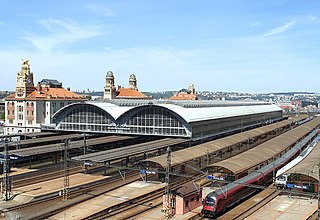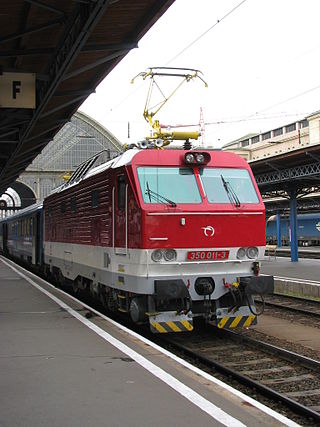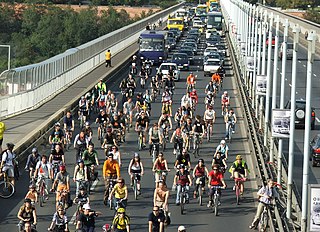
Prague is the capital and largest city of the Czech Republic, and the historical capital of Bohemia. On the Vltava river, Prague is home to about 1.3 million people. The city has a temperate oceanic climate, with relatively warm summers and chilly winters.
Arriva plc is a British multinational public transport company headquartered in Sunderland, England. It was established in 1938 as T Cowie Ltd. and following a number of mergers and acquisitions was rebranded Arriva in 1997. It became a subsidiary of Deutsche Bahn in 2010. Arriva operates bus, coach, train, tram and waterbus services in 14 countries across Europe. As of September 2018, it employed 61,845 people and operated 2.4 billion passenger journeys annually. It operates as three divisions: UK Bus, UK Rail and Mainland Europe. Deutsche Bahn announced in 2019 that it wished to sell Arriva, but the sale was placed on hold as of November in that year.

Václav Havel Airport Prague, formerly Prague Ruzyně International Airport, is the international airport of Prague, the capital of the Czech Republic. The airport was founded in 1937, when it replaced the Kbely Airport. It was reconstructed and extended in 1956, 1968, 1997, and 2006. In 2012, it was renamed after the last president of Czechoslovakia and the first president of the Czech Republic, Václav Havel. It is located at the edge of the Prague-Ruzyně area, next to Kněževes village, 12 km (7 mi) west of the centre of Prague and 12 km (7 mi) southeast of the city of Kladno.
České dráhy, often shortened to ČD, is the major railway operator in the Czech Republic providing regional and long-distance services.

Prague 1, formally the Prague 1 Municipal District, is a second-tier municipality in Prague. It is co-extensive with the national administrative district of the same name.

Praha hlavní nádraží is the largest railway station in Prague, Czech Republic.

Slovenská strela is the name of an express train, first operated by ČSD in Czechoslovakia on the line between Bratislava and Prague.

The Děčín–Dresden railway, also called the Elbe Valley Railway is an electrified main line in Saxony and the Czech Republic. Formerly called the Saxon-Bohemian State Railway, the line is part of the Dresden to Prague route and is one of Europe's most important trunk routes (Magistralen). It runs along the Elbe Valley from Děčín via Bad Schandau and Pirna to Dresden. The first section of the line was opened in 1848 and is one of the oldest lines in Germany.

RegioJet a.s. is a private Czech provider of passenger rail and bus transport. The company Student Agency, owned by Czech businessman Radim Jančura, is the sole owner. A sister company of the same name, with its registered office in Bratislava, is an operator of passenger rail and bus transport in Slovakia.

Rail transport in the Czech Republic carried 193.5 million passengers in 2019, and 68.37 million tonnes of cargo in the year 2009. The majority of passenger services run nowadays are operated by the state company České dráhy, which until 2007 also managed cargo services now run by ČD Cargo. In 2009 the country had 9,420 km of standard gauge track, 3,153 km of which is electrified. There are two main electrification systems in the Czech Republic, 3 kV DC in the northern part, and 25 kV 50 Hz AC in the south. Locomotives had to be changed on boundaries in the past, two-system locomotives have been introduced in 1974. The network has same gauge links to all four countries bordering the Czech Republic with passenger services to all four countries in operation. Major hubs for international passenger services on the network are in Prague, Ostrava, Brno and Břeclav, and the busiest station is Praha hlavní nádraží. Maximum speed on Czech rails is 160 km/h (99mph).

Praha-Smíchov railway station is a major railway station in Prague, Czech Republic, located in Smíchov, in the south-west of the city. It serves as a major railway station on the Czech national rail network, and is connected to the rest of Prague by its metro station of the same name and numerous tram routes which stop on Nádražní street outside the station. It is also a major bus terminus for lines going to the south and southwest of Prague and beyond. In 2009 the station served almost 4 million people.

Hungaria is a EuroCity train which runs between Budapest Nyugati and Hamburg - Altona, currently running with coaches of MÁV. It is numbered as EC 252-253 and runs daily, mainly with MÁV owned rolling stocks.

Varsovia, the Neo-Latin word for Warsaw, Poland, has been the name of two distinct EuroCity international express trains, each of them originating and terminating in Warsaw.
Progress was an express train between Prague, then the capital of Czechoslovakia, and the German Democratic Republic (GDR).
The Primator was an international express train. Introduced in 1986, it ran between Prague, then the capital of Czechoslovakia, and East Berlin, then the capital of the German Democratic Republic (GDR).
The Porta Bohemica is a EuroCity (EC) international express train. Since December 2014 it is operating between Hamburg-Altona and Budapest Keleti.
The Comenius has been the name of two distinct EuroCity (EC) international express trains, both of them originating, terminating or passing through Prague, the capital of the Czech Republic.

The Sobieski is a EuroCity (EC) international express train. Introduced in 1994, it runs between Vienna, the capital of Austria, and Warsaw, the capital of Poland, via the Czech Republic.

The Polonia is a EuroCity (EC) express train. It was introduced in 1997, to supplement the existing EuroCity train, the Sobieski, on the international route between Vienna, the capital of Austria, and Warsaw, the capital of Poland, via the Czech Republic.

Cycling in Prague is a popular leisure activity and a not so common mode of transport within the capital city of the Czech Republic. However, levels of utility cyclists have been rising recently. In 2018, 2% of people commuted by bike in Prague. As of 2017, there were 178 km (111 mi) of protected cycle paths and routes in the city. Also, there are 48 km (30 mi) of bike lanes and 24 km (15 mi) of specially marked bus lanes that can be used by cyclists.














